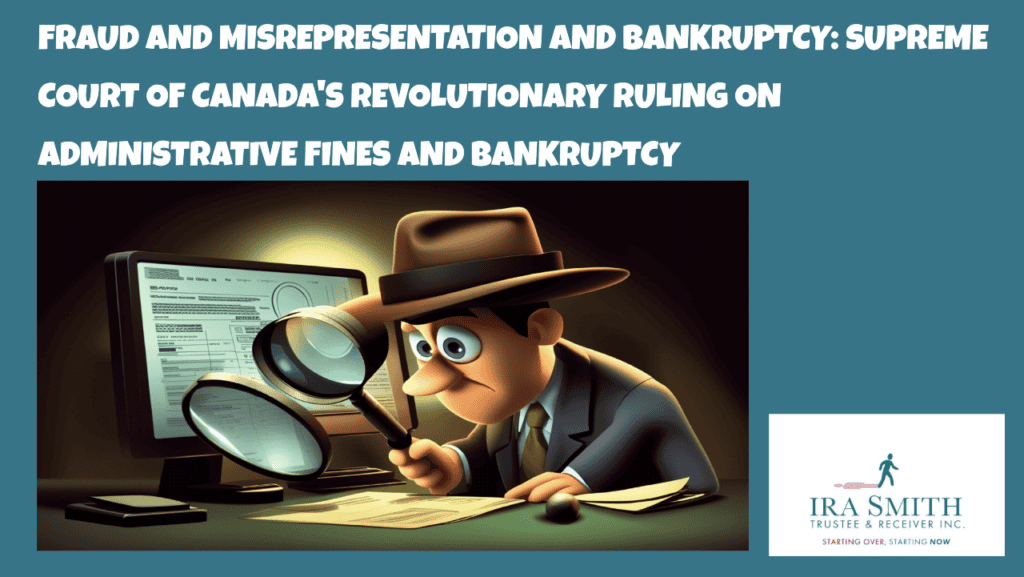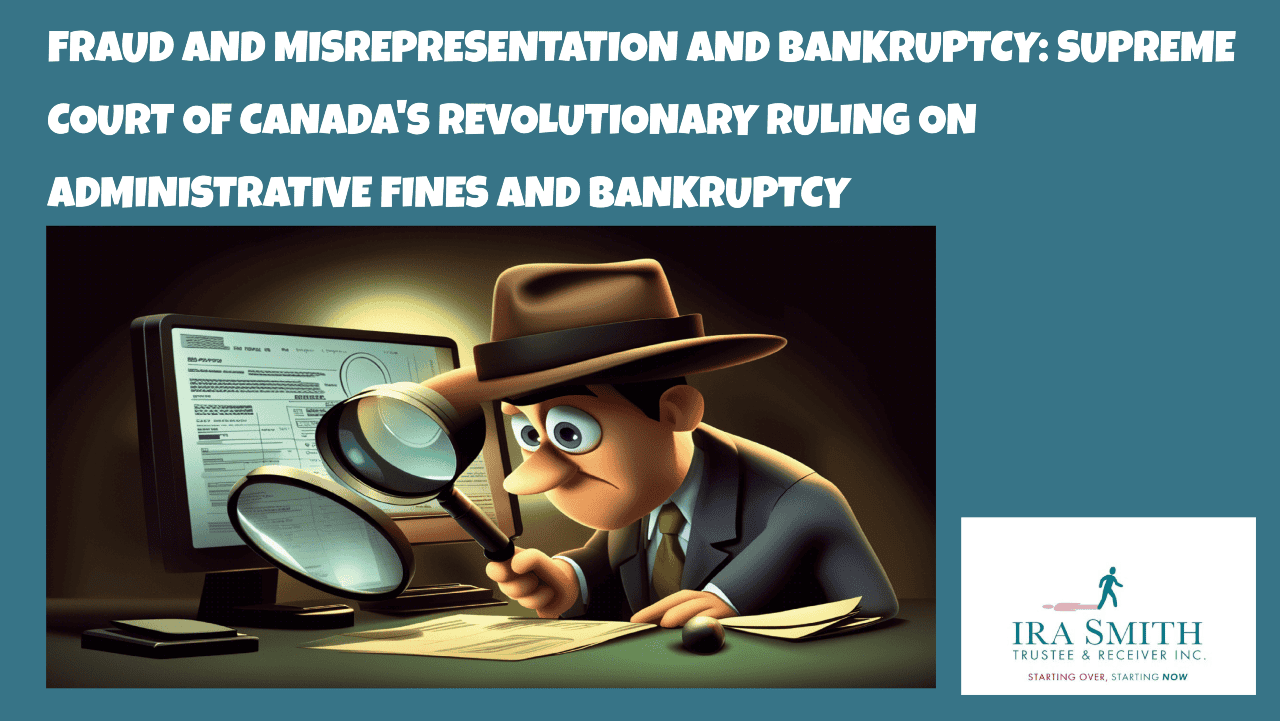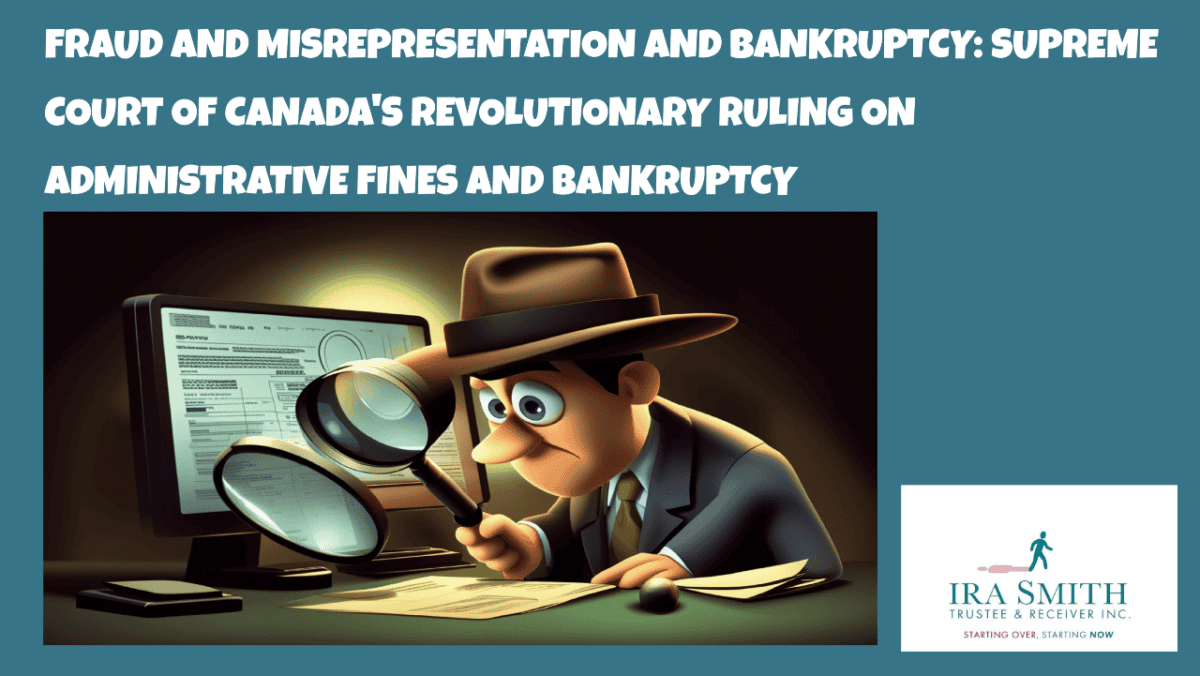Fraud and Misrepresentation: Introduction
On July 31, 2024, the Supreme Court of Canada released its decision in the case of Poonian v. British Columbia (Securities Commission), 2024 SCC 28. This appeal to the Supreme Court was heard on December 6, 2023. The Canadian insolvency community has been anxiously awaiting this decision to drop.
Thalbinder Singh Poonian and Shailu Poonian engaged in market manipulation that caused vulnerable investors to lose millions of dollars. The British Columbia Securities Commission (BCSC) found that they had contravened the province’s Securities Act. It ordered them to pay $13.5 million in administrative penalties; it also ordered them to disgorge approximately $5.6 million, which represented the amounts they obtained as a result of the market manipulation fraud and misrepresentation scheme.
These sanctions were registered with the Supreme Court of British Columbia under the Securities Act, which provides that, on being filed in a registry of that court, a decision of the BCSC has the same force and effect, and all proceedings may be taken on it as if it were a judgment of that court.
On April 20, 2018, the Poonians initiated a voluntary assignment in bankruptcy. Subsequently, on February 13, 2020, they sought a discharge from bankruptcy; however, this request was opposed by both the BCSC and the Canada Revenue Agency. On April 8, 2020, the Supreme Court of British Columbia denied the Poonians’ application, and as a result, they continue to remain undischarged bankrupts to this day.
In this Brandon’s Blog, I discuss the decision of the Supreme Court of Canada in this case. The Poonian case stems from stock market manipulation, fraud and misrepresentation. It highlights the intersection of fraud, bankruptcy law, and investor protection. Its impact stresses the need for reform to ensure accountability for dishonest practices while fostering trust in financial markets. The ruling may serve as a crucial step towards a more ethical financial landscape.
Fraud and Misrepresentation: The Core Issues of the Case
Delving into the intricacies of the case provides a rich tapestry of legal nuances that underscore the importance of regulatory frameworks in financial markets. The case was centred around the role of the BCSC, a critical entity in safeguarding investor interests and maintaining the integrity of the marketplace.
An important question arose: could the
administrative penalties and disgorgement orders imposed by the BCSC withstand the complexities introduced by bankruptcy discharges as delineated in the Bankruptcy and Insolvency Act (Canada) (BIA)? This question reflects legal intricacies and highlights ethical implications in financial governance.
First, let’s examine the significant penalties. The case’s details reveal staggering financial penalties: Thalbinder Poonian was hit with a hefty $13.5 million administrative penalty, while his partner, Shailu Poonian, faced $3.5 million. Additionally, a $5.6 million disgorgement order was made by the BCSC representing the Poonians’ illicit gains from their fraud and misrepresentation activities between 2007 and 2009.
The BCSC applied to the Supreme Court of British Columbia for a declaration that the debts represented by the administrative penalties and disgorgement orders not be released by any order of discharge, under s.178(1)(a), (d) and (e) of the BIA. The chambers judge allowed the BCSC’s application, finding that the debts were exempt and would survive any discharge. While only one exception had to apply for the debts not to be released, the chambers judge found the exceptions in s. 178(1)(a) and (e) both applied.
The Poonians filed an appeal with the British Columbia Court of Appeal, contesting, among other points, the chambers judge’s interpretation of the Bankruptcy and Insolvency Act (BIA). Justice Willcock, representing the British Columbia Court of Appeal, determined that the chambers judge had made an error in concluding that the debts were exempt from discharge under section 178(1)(a) of the BIA. However, the court upheld the chambers judge’s finding that the debts were exempt under section 178(1)(e). As the debts were deemed exempt, albeit only under section 178(1)(e), the appeal was ultimately dismissed.
Not satisfied with this result, the Poonians appealed to the Supreme Court of Canada. Before delving into the findings of the Supreme Court of Canada, we should review some basics about the BIA.

The Legal Background of Bankruptcy and Fraud and Misrepresentation
The Bankruptcy and Insolvency Act
The Supreme Court’s analysis of the BIA centred on interpreting and applying the exceptions listed under section 178(1) in the context of the Poonian v. British Columbia Securities Commission case. Here are the key aspects of the court’s analysis:
Financial Rehabilitation and Fresh Start Principle:
- The court acknowledged the primary objective of the BIA, which is to facilitate the financial rehabilitation of debtors by enabling them to achieve a fresh start and relief from burdensome debt.
- Subsection 178(2) of the BIA delineates the fresh start principle, permitting an honest yet unfortunate debtor to be discharged from outstanding debts upon completing the bankruptcy process.
Limits of Financial Rehabilitation:
- The court acknowledged that while financial rehabilitation is a key goal of the BIA, it is not unlimited. There must be a proper balance of interests. Sections 172 and 178(1) of the BIA set out specific debts and considerations that balance financial rehabilitation with other policy objectives.
Section 178(1) Exceptions:
- The court highlighted that Section 178(1) enumerates particular debts that are not extinguished by discharge and consequently persist beyond bankruptcy. This provision reflects Parliament’s intention to reconcile financial rehabilitation with other policy objectives, including the maintenance of confidence in the credit system.
Specific Debt Exemptions:
- The court addressed exemptions under sections 178(1)(a) and 178(1)(e) of the BIA, which were central to the case.
- Section 178(1)(a) relates to fines, penalties, restitution orders, recognizances, bail, and orders imposed by a court (emphasis added). The court interpreted this subsection to clarify its scope and application to the BCSC’s orders.
- Section 178(1)(e) pertains to debts or liabilities resulting from obtaining property or services by false pretenses or fraudulent misrepresentation. The court provided a detailed analysis of the elements and requirements of this subsection concerning the case at hand.
Interpretation of Court Orders:
- There was an analysis of the effect of administrative tribunal decisions being registered as judgments of a court and whether they fall under the exemptions listed in section 178(1)(a) of the BIA.
Decision on Exemptions:
- Ultimately, the court determined whether the administrative penalties and disgorgement orders in the Poonian case were exempt from discharge under section 178(1)(a) and (e).
Overall, the court’s analysis primarily focused on the relevant exceptions under section 178(1) of the BIA, their interpretation, and their application to the specific circumstances of the case.
Section 178(1) Explained
The legal background of bankruptcy concerning fraud and misrepresentation involves specific elements that need to be established for a debt or liability to survive bankruptcy under section 178(1)(e) of the BIA. Here are the key points in the Supreme Court analysis related to this legislative history:
False Pretences or Fraudulent Misrepresentation:
- The first requirement is for the creditor to prove that the debts or liabilities were obtained as a result of the debtor’s false pretences or fraudulent misrepresentation.
- A court cannot infer fraud easily and must independently review the evidence presented.
- Judicial notice of fraud is not admissible, and fraud cannot be inferred in a cursory manner.
- The creditor must establish that a deceitful statement was made, which was false, made knowingly without belief in its truth, and that the creditor relied on it and suffered a loss as a result.
Passing of Property or Provision of Services:
- The second requirement involves a loss in the form of a transfer of property or delivery of services, resulting in a corresponding debt or liability.
- The bankrupt need not be the direct recipient of the property. It can pass indirectly from the person to a third party at the bankrupt’s direction.
- The property need not be obtained or retained by the bankrupt, but the fraudulent misrepresentation must induce a person to give the property to the bankrupt or someone associated with the bankrupt.
Link between Debt or Liability and Fraud:
- The debt or liability must have been created as a direct result of false pretences or fraudulent misrepresentation.
- The court must ensure a clear and cogent link between the deceitful conduct and the resulting debt or liability.
- Even if findings of fraud have been made by an administrative decision-maker, the court must make its determination based on a review of the evidence.
In summary, the legal background of bankruptcy and fraud/misrepresentation involves stringent requirements to establish that debts or liabilities were obtained through deceitful actions, resulting in a loss of property or services, and directly linked to the fraudulent conduct. These elements are essential for determining whether a debt or liability can survive bankruptcy under the BIA.
Fraud and Misrepresentation: The Appeal To The Supreme Court
The Supreme Court’s Decision
The Supreme Court’s majority opinion dismissing this appeal by the Poonians written by Justice Côté now provides clarity on the matter. The SCC affirmed that the disgorgement orders are monetary sanctions imposed because of, and thus resulting from, deceitful conduct or dishonest conduct that Parliament specifically sought to address. They are debts that originate from the Poonians having obtained property by false pretences or fraudulent misrepresentations. Accordingly, the disgorgement order falls within the narrow scope of s. 178(1)(e) and should not be released by any order of discharge from bankruptcy. The Supreme Court majority decision decided that the administrative penalties do not fall under any of the section 178(1) exemptions, be it section 178(1)(a) or (e).
This decision illuminates the understanding that the BCSC’s disgorgement order was closely tied to the fraudulent actions of the Poonians, which had directly inflicted financial harm on investors, but the administrative penalties were not. In essence, the court recognized that allowing the disgorgement order to be discharged would go against the spirit of the law designed to root out fraudulent behaviour.
The dissenting opinion from Justices Karakatsanis and Martin also adds an intriguing layer to this narrative. They concurred with the majority opinion for the survival of the disgorgement order under BIA sections 178(1)(e), but they would have given the administrative penalties the same treatment. The dissenting Justices advocated for the idea that all the underlying actions constituted fraud. However, their dissenting opinion did not alienate them from the majority opinion on the disgorgement order.
The Poonian case highlights the critical tension between providing pathways for honest debtors and preventing those engaged in deceit from reaping financial rewards for their actions. It is a reminder that while bankruptcy law aims to provide relief, it should not create loopholes that enable fraudsters to escape accountability. The dissonance between the aims of the BIA and the realities of financial misconduct presents a significant challenge but also an opportunity to fortify legal structures that prioritize the trustworthiness of our financial systems.
The Supreme Court’s Detailed Analysis of Section 178(1) of the BIA
To fully grasp the nuances of bankruptcy discharges, understanding Section 178(1) is crucial. This section explicitly lists categories of debts that a bankruptcy discharge does not cover. Specifically, it sets out parameters that determine if a debt may survive the bankruptcy process.
- Subsection (a) targets amounts that are deemed penalties specifically imposed by a court for offences.
- Subsection (e), on the other hand, relates to non-dischargeable debts that arise from unlawful acquisition of property through fraudulent misrepresentation.
Through the context of Poonian’s case, we begin to see the implications of these distinctions. The Supreme Court directly confronted whether the administrative penalties levied against the Poonians did not fall under the non-dischargeable categories, notwithstanding these penalties had been registered with the BC court.
Differences Between Court-Imposed Penalties and Administrative Fines
One of the critical distinctions I’ve noticed is how court-imposed penalties differ fundamentally from administrative fines. Administrative penalties are typically issued by regulatory agencies for violations of regulation rather than for conduct termed by law. In the case at hand, the penalties were administered by the BCSC, which is an administrative body. It was not a decision of the Court.
The Supreme Court highlighted that for the context of subsection (a), penalties need to originate from a court ruling to classify as “court-imposed.” The Justices affirmed neither the administrative penalties nor the disgorgement orders stemming from the BCSC fell under subsection 178(1)(a). Conversely, it recognized that only the disgorgement order debt could indeed be assessed under subsection 178(1)(e) because they arose from the fraudulent actions committed by the Poonians, aligning such misconduct directly with fraudulent misrepresentation.

Fraud and Misrepresentation: Real-Life Implications for Those Facing Bankruptcy
While exploring this judicial decision, let’s not overlook the real-world implications for individuals grappling with the aftermath of bankruptcy. Bankruptcy proceedings are not simply academic exercises; they represent often hard-fought battles for individuals and families seeking finality and relief from oppressive debt. However, as this case illustrates, an individual’s past actions in the realm of fraud can significantly affect their future financial recovery.
The situation faced by Thalbinder and Shailu Poonian serves as a cautionary tale. After executing a fraudulent market manipulation scheme that inflicted massive financial losses on investors, they found themselves facing not only civil penalties but also the complexities of bankruptcy law that would determine if certain of their debts could not be discharged through the bankruptcy process. Their case spotlighted how, even while seeking refuge under the BIA, the weight of their actions continued to haunt them—shaping their financial reality moving forward.
In the context of fraud and misrepresentation, the legal system takes a firm stance. The Supreme Court underscored that despite bankruptcy serving as a fresh start for many, there remains a clear societal interest in holding those who engage in fraudulent conduct accountable. As one legal expert succinctly articulated,
“It’s essential to maintain the balance between allowing recovery and punishing fraudulent behaviour.”
Upon reviewing the rulings, it becomes evident that the relationship between administrative penalties and bankruptcy discharges presents significant complexities. The evolving nature of jurisprudence underscores the importance of seeking experienced legal counsel for individuals navigating these circumstances. Cases such as that of the Poonians highlight the enduring repercussions of dishonesty in business transactions and the stringent scrutiny that follows in the legal arena.
Moreover, Section 178(1) serves as an essential protective measure against unscrupulous debtors, holding accountable those who exploit the bankruptcy system for personal gain. It is imperative to emphasize that not all debts are treated equitably in bankruptcy proceedings, particularly for individuals who have acquired property through fraud and misrepresentation.
Fraud and Misrepresentation: The Broader Legal Implications of the Ruling
In reflecting on the Supreme Court ruling in this case, I am struck by the potential ramifications for future cases involving a fraudulent scheme and bankruptcy. The ruling not only clarifies certain provisions under the BIA but also highlights that the majority opinion shapes the legal discourse for years to come.
The core issue at stake was whether administrative penalties and disgorgement orders could withstand bankruptcy discharges. The Poonians, who engaged in a significant market manipulation scheme causing notable losses to investors, faced substantial sanctions totalling over $17 million. What caught my attention was the legal reasoning applied by the judges concerning subsections of the BIA — particularly around the distinction of what constitutes a “penalty imposed by a court.” The majority decision concluded that the disgorgement orders could indeed be non-dischargeable, while they dismissed the administrative penalties under section 178(1).

Fraud and Misrepresentation: Impact on Future Cases
The implications of this ruling extend far beyond the immediate case. The way future fraud cases are adjudicated may fundamentally change as a consequence of this decision. From my perspective, the judicial reasoning employed could pave the way for stricter enforcement of certain penalties against those engaging in fraudulent activity. At the same time, the reasoning, in this case, can be extended to all administrative tribunals charged with maintaining the trust the public can place in the industry they regulate.
I can envision that future court rulings will be influenced by the emphasis placed on the fraudulent behaviour of the individuals involved. If future courts lean towards the rationale demonstrated here, it might deter would-be fraudsters from riskier financial behaviour due to the heightened likelihood of facing non-dischargeable debts post-bankruptcy.
Furthermore, this case might serve as a benchmark for evaluating the legitimacy and scope of financial penalties imposed not only by commissions like the BCSC but also by regulatory bodies across Canada. When I think about the potential for greater clarity in judicial interpretation, I am both hopeful and curious about its influence on how we perceive financial accountability in society at large.
Fraud and Misrepresentation: Conclusion
As I sift through the implications of this Supreme Court decision, I can’t help but reflect on how the outcomes resonate far beyond the courtroom. The repercussions of this case reach every corner of the investment community, sending ripples into regulatory frameworks that must adapt to this reality.
The Poonians were found guilty of orchestrating fraud and misrepresentation through their stock manipulation activities that significantly harmed countless investors. The Supreme Court’s ruling, emphasizes a crucial principle: while bankruptcy laws may offer a fresh start, they should not protect those who engage in unethical conduct.
I hope you enjoyed this fraud and misrepresentation Brandon’s Blog. Do you or your company have too much debt? Are you or your company in need of financial restructuring? The financial restructuring process is complex. The Ira Smith Team understands how to do a complex restructuring. However, more importantly, we understand the needs of the entrepreneur or someone with too much personal debt.
You are worried because you are facing significant financial challenges. It is not your fault that you are in this situation. You have been only shown the old ways that do not work anymore. The Ira Smith Team uses new modern ways to get you out of your debt troubles while avoiding bankruptcy. We can get you debt relief freedom.
The stress placed upon you is huge. We understand your pain points. We look at your entire situation and devise a strategy that is as unique as you and your problems; financial and emotional. The way we take the load off of your shoulders and devise a plan, we know that we can help you.
We know that people facing financial problems need a realistic lifeline. There is no “one solution fits all” approach with the Ira Smith Team.
That is why we can develop a restructuring process as unique as the financial problems and pain you are facing. If any of this sounds familiar to you and you are serious about finding a solution, contact the Ira Smith Trustee & Receiver Inc. team today.
Call us now for a free consultation. We will get you or your company back on the road to healthy stress-free operations and recover from the pain points in your life, Starting Over, Starting Now.
The information provided in this Brandon’s Blog is intended for educational purposes only. It is not intended to constitute legal, financial, or professional advice. Readers are encouraged to seek professional advice regarding their specific situations. The content of this Brandon’s Blog should not be relied upon as a substitute for professional guidance or consultation. The author, Ira Smith Trustee & Receiver Inc. as well as any contributors to this Brandon’s Blog, do not assume any liability for any loss or damage resulting from reliance on the information provided herein.





